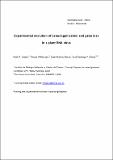Por favor, use este identificador para citar o enlazar a este item:
http://hdl.handle.net/10261/92594COMPARTIR / EXPORTAR:
 SHARE SHARE
 CORE
BASE CORE
BASE
|
|
| Visualizar otros formatos: MARC | Dublin Core | RDF | ORE | MODS | METS | DIDL | DATACITE | |

| Título: | Experimental evolution of pseudogenization and gene loss in a plant RNA virus |
Autor: | Elena, Santiago F. CSIC ORCID ; Daròs Arnau, José Antonio CSIC ORCID ; Zwart, Mark P. CSIC ORCID | Fecha de publicación: | 2014 | Editor: | Oxford University Press | Citación: | Molecular Biology and Evolution 31:(1) 121- 134 (2014) | Resumen: | Viruses have evolved highly streamlined genomes and a variety of mechanisms to compress them, suggesting that genome size is under strong selection. Horizontal gene transfer has, on the other hand, played an important role in virus evolution. However, evolution cannot integrate initially nonfunctional sequences into the viral genome if they are rapidly purged by selection. Here we report on the experimental evolution of pseudogenization in virus genomes using a plant RNA virus expressing a heterologous gene. When long 9-week passages were performed, the added gene was lost in all lineages, whereas viruses with large genomic deletions were fixed in only two out of ten 3-week lineages and none in 1-week lineages. Illumina next-generation sequencing revealed considerable convergent evolution in the 9- and 3-week lineages with genomic deletions. Genome size was correlated to within-host competitive fitness, although there was no correlation with virus accumulation or virulence. Within-host competitive fitness of the 3-week virus lineages without genomic deletions was higher than for the 1-week lineages. Our results show that the strength of selection for a reduced genome size and the rate of pseudogenization depend on demographic conditions. Moreover, for the 3-week passage condition, we observed increases in within-host fitness, whereas selection was not strong enough to quickly remove the nonfunctional heterologous gene. These results suggest a demographically determined >sweet spot> might exist, where heterologous insertions are not immediately lost while evolution can act to integrate them into the viral genome. © 2013 The Author 2013. Published by Oxford University Press on behalf of the Society for Molecular Biology and Evolution. | URI: | http://hdl.handle.net/10261/92594 | DOI: | 10.1093/molbev/mst175 | Identificadores: | doi: 10.1093/molbev/mst175 issn: 0737-4038 e-issn: 1537-1719 |
| Aparece en las colecciones: | (IBMCP) Artículos |
Ficheros en este ítem:
| Fichero | Descripción | Tamaño | Formato | |
|---|---|---|---|---|
| Zwart et al. Mol. Biol. Evol.pdf | 4,94 MB | Adobe PDF |  Visualizar/Abrir |
CORE Recommender
PubMed Central
Citations
20
checked on 22-abr-2024
SCOPUSTM
Citations
25
checked on 24-abr-2024
WEB OF SCIENCETM
Citations
27
checked on 27-feb-2024
Page view(s)
407
checked on 23-abr-2024
Download(s)
344
checked on 23-abr-2024
Google ScholarTM
Check
Altmetric
Altmetric
Artículos relacionados:
NOTA: Los ítems de Digital.CSIC están protegidos por copyright, con todos los derechos reservados, a menos que se indique lo contrario.
